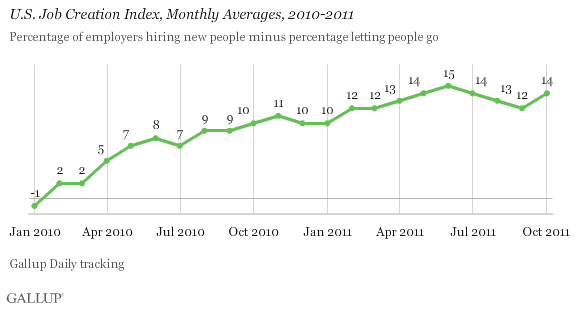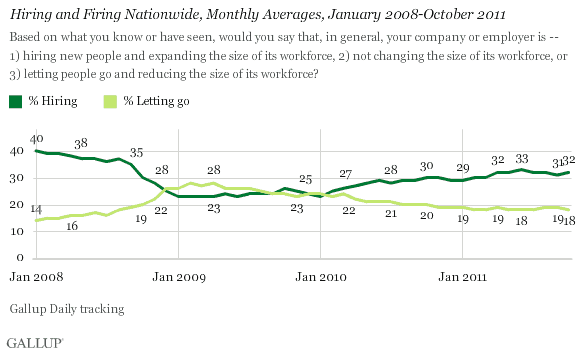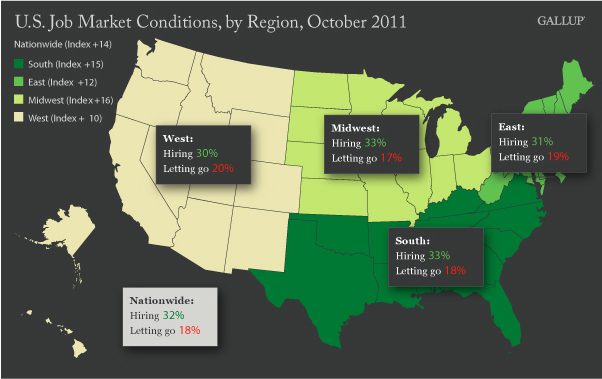PRINCETON, NJ -- Job market conditions in the United States improved in October, as Gallup's Job Creation Index increased to +14 from +12 in September. This reverses the three-month downward trend seen from July to September. The index is also higher than its +10 reading in October 2010.

Hiring Up, While Firing Is Down
The percentage of employees who say their companies are hiring and expanding the size of their workforces increased, while the number who say their companies are letting workers go and reducing the size of their workforces decreased. The October Job Creation Index of +14 is based on 32% of workers nationwide saying their employers are hiring and 18% saying their employers are letting workers go. Hiring is up from 31% and firing is down from 19% in September.

Job Market Conditions Improve in All Regions Except West
Job market conditions improved in October in all regions except the West. Job market conditions remain best in the Midwest, where the Job Creation Index is +16, and in the South, at +15. The Index is +12 in the East, but fell to +10 in the West. These patterns suggest there could be a modest bounceback in manufacturing, given that several Institute for Supply Management measures have also improved.

Implications
The improvement in the Gallup Job Creation Index is consistent with the decrease in unemployment Gallup's Daily tracking registered during October. Some of the improvement in current job conditions may be attributable to seasonal hiring -- Gallup's jobs data are not seasonally adjusted -- but the magnitude of change suggests there is also a real improvement taking place in company hiring and firing activities.
It may be that the improvement in October hiring is at least partly the result of a lagged response after the U.S. GDP grew at a stronger 2.5% rate for the third quarter. It may also result from increased hiring as retailers -- previously operating at minimum staff levels -- have hired to help bolster their workforces for the holidays.
Regardless, Gallup's October jobs data suggest the government -- in contrast to the current consensus -- will report a decline in the U.S. unemployment rate this Friday. Much of this job market improvement may prove temporary, but for now it appears to be real, and any job growth is beneficial when so many Americans are looking for work.
Gallup.com reports results from these indexes in daily, weekly, and monthly averages and in Gallup.com stories. Complete trend data are always available to view and export in the following charts:
Daily: Employment, Economic Confidence and Job Creation, Consumer Spending
Weekly: Employment, Economic Confidence, Job Creation, Consumer Spending
Read more about Gallup's economic measures.
View our economic release schedule.
Survey Methods
For Gallup Daily tracking, Gallup interviews approximately 1,000 national adults, aged 18 and older, each day. The Gallup Job Creation Index results are based on a random sample of approximately 500 current full- and part-time employees each day.
National results for October are based on Gallup Daily tracking interviews with 17,330 employees conducted Oct. 1-30, 2011. For this sample, one can say with 95% confidence that the maximum margin of sampling error is ±1 percentage point. Regional results for October are based on interviews totaling more than 3,000 in each region. For each total regional sample, the maximum margin of sampling error is ±3 percentage points.
Interviews are conducted with respondents on landline telephones and cellular phones, with interviews conducted in Spanish for respondents who are primarily Spanish-speaking. Each sample includes a minimum quota of 400 cell phone respondents and 600 landline respondents per 1,000 national adults, with additional minimum quotas among landline respondents by region. Landline telephone numbers are chosen at random among listed telephone numbers. Cell phone numbers are selected using random-digit-dial methods. Landline respondents are chosen at random within each household on the basis of which member had the most recent birthday.
Samples are weighted by gender, age, race, Hispanic ethnicity, education, region, adults in the household, and phone status (cell phone only/landline only/both, cell phone mostly, and having an unlisted landline number). Demographic weighting targets are based on the March 2010 Current Population Survey figures for the aged 18 and older non-institutionalized population living in U.S. telephone households. All reported margins of sampling error include the computed design effects for weighting and sample design.
In addition to sampling error, question wording and practical difficulties in conducting surveys can introduce error or bias into the findings of public opinion polls.
For more details on Gallup's polling methodology, visit www.gallup.com.
